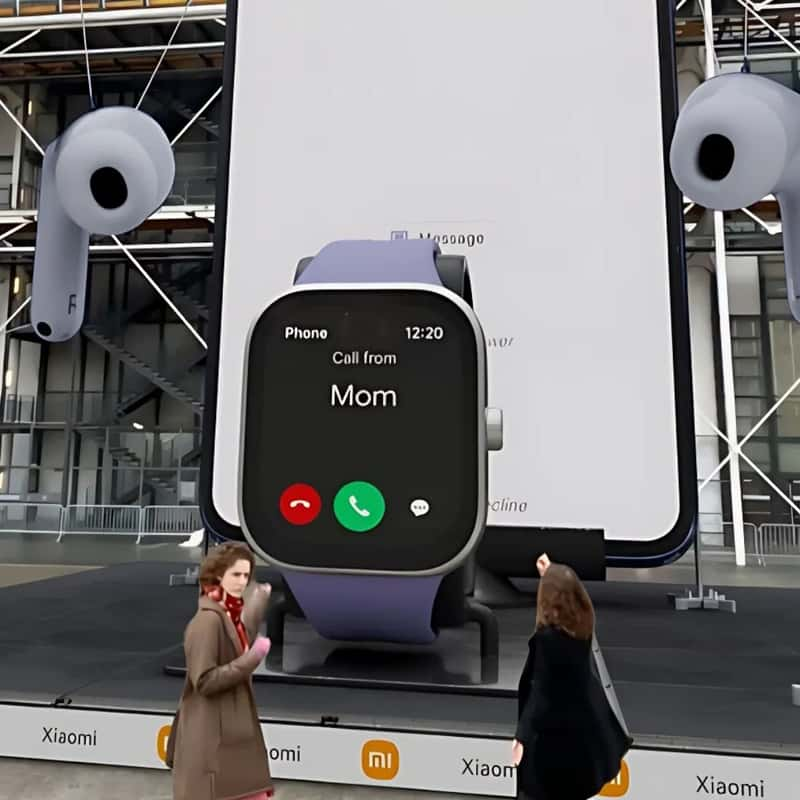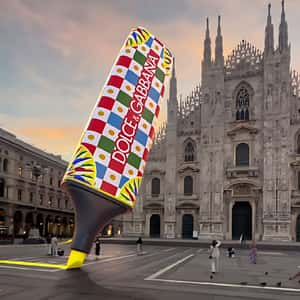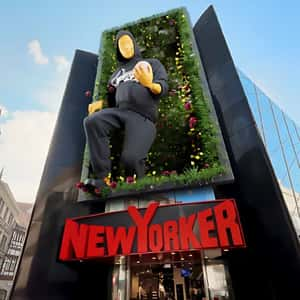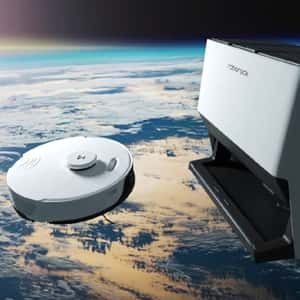How AR Will Redefine FOOH Advertising in 2025
AR is taking marketing to the next level by turning ads into interactive experiences. Find out how it could change Fake OOH Advertising in 2025.

Augmented reality, or AR, is a rapidly evolving technology that’s reshaping how brands connect with audiences. Analysts expect the market for AR to top $230 billion by 2032. And this technology will play a vital role in boosting marketing strategies in 2025. [1]
AR is no longer a novelty – it’s becoming a core component of modern marketing strategies. From interactive filters to virtual try-ons, AR enhances engagement by blending the digital and physical worlds.
But what happens when you combine this interactivity with Fake Out-of-Home (FOOH) Advertising? This digital ad format is currently redefining traditional advertising on social media through hyper-realistic CGI.
As these two kinds of advertisement continue to evolve, their combined potential offers brands new ways to craft show-stopping, interactive campaigns that leave a lasting impression.
This article will look at how AR and fake OOH advertising will change marketing. We’ll discuss why they work well together and how brands can use them to boost their next campaign.
Want to learn more about Fake OOH Advertising? Check out our FOOH Beginner’s Guide for 2025.
How AR and FOOH Are Changing Advertising
AR isn’t anything new to the customer experience. Brands like Snapchat and Instagram already use it in their platforms with features like face filters.
Perhaps you’ve seen interactive ads or lenses that let you try on products. AR is already a significant part of customers’ daily shopping experiences. The immersiveness of the AR experience is what makes it such a natural fit for Fake Out of Home.
While AR brings personalization and interactivity, FOOH delivers the wow factor and sets the stage through ads with clever interactive storytelling and otherworldly visuals on social media.
Fake OOH Advertising is not like traditional out-of-home ads, which include static billboards and posters. Instead, it offers a lively, digital-only experience.
FOOH merges realistic 3D renderings with footage from actual locations. The result? Ads that appear so real, they capture viewers’ attention immediately. The marriage of the digital and physical worlds sets FOOH Advertising apart, enabling brands to craft bold, eye-catching campaigns that suit today’s highly visual, social media-driven culture.
Want to see more great FOOH Advertising examples? Check out our CGI Ad Library.
When combined with AR, FOOH isn’t just about creating visually stunning ads – it’s about giving audiences a way to experience them. Take Vodafone’s campaign in Germany, for example. They ran a FOOH ad to hype up their AR campaign. And the results were impressive. [2]
The ad displayed a giant 3D CGI poster in a digital setting. It had a QR code inviting viewers to “Scan and Win.” Out of nowhere, a giant box zooms in and dumps hundreds of smiley balls. They scatter across the digital space, bounce onto the streets, and drift up into the sky.
The ad ends with the tagline, “Together is better. In every GigaKombi.”
This Fake Out of Home ad gave people a glimpse of what the AR experience would feel like. When you scanned the QR code in real life, you’d unlock an interactive 360-degree AR world on your phone.
You’d spot virtual emojis, balloons, and a 3D wheel for Vodafone’s GigaKombi products. And they fit right into your surroundings thanks to your phone’s camera. It’s a perfect example of how FOOH Advertising and AR can complement each other in amplifying the customer experience both online and in the real world.
4 Reasons Why AR is the Perfect Fit for Fake OOH Advertising
AR and FOOH Advertising are transforming the advertising landscape in ways that weren’t possible even a few years ago. AR makes observers into participants, while FOOH’s eye-catching visuals capture attention with ease. Together, they create immersive campaigns that change the way we connect.
Here’s how AR will revolutionize FOOH in 2025:
1. Interactive and personalized engagement
AR takes fake OOH Advertising to a whole new level by making it interactive and engaging. Instead of watching an ad, you can actively interact with it in the real world using AR. Take the Vodafone campaign from earlier as an example.
The FOOH ad showed what the AR experience would feel like when scanning the QR code. Objects coming to life from the billboard onto the streets, and even offering rewards like discounts or freebies at nearby stores.
This type of experience strengthens the brand connection. The audience isn’t simply watching your Fake Out of Home ad; they’re fully experiencing the whole campaign.
And when people do visit your campaign in person after seeing the FOOH ad, the AR experience feels personal and rewarding. It doesn’t come off as clickbait because FOOH does a better job of showcasing AR ads in an authentic and engaging way.
And it doesn’t stop there. Your FOOH ad can attract attention beyond its location. It can bring in more viewers and engagement from people who might not have visited otherwise.
Although it may not directly enhance interaction with the OOH ad itself, your brand gains increased visibility and is recognized as a pioneer for undertaking something unique and innovative.
2. Enhanced storytelling
Augmented reality takes the storytelling potential of Fake Out of Home to a whole new level. AR lets brands craft rich, immersive stories that surpass regular video content.
For example, a geo-located collecting game (such as Pokémon GO) could encourage users to gather 50 virtual coins scattered around the city. Once completed, they receive a 10% discount for their next shopping trip. This kind of gamification not only grabs attention but also drives real-world interaction with brands.
By combining AR and Fake OOH Advertising, brands can craft campaigns that resonate emotionally with their audiences. Storytelling makes a product feel real. It lets users explore adventures and connect with a brand’s vision. This approach makes the story more vivid, memorable, and easy to share.
These interactive stories keep people engaged longer. It gives brands more chances to make a lasting impression and show off their creativity and innovation.
3. Data-driven insights
AR makes it so much easier for brands to track how their campaigns are performing. Every time a person uses an AR experience, like scanning a QR code or claiming an offer, we can track that data.
This gives brands useful information. They can see how long people engage, how often they interact, and how many turn into customers.
To put this into another example: An interactive FOOH ad for a makeup item could have a QR code on its OOH advertisement. You scan the OOH ad, and a game pops up. Players collect falling items with a bucket. After gathering 10 items, they earn a 10% voucher to use indoors. Brands can track how many people scanned the code and how many went to redeem the offer at a nearby store.
This doesn’t just measure the AR experience. It also shows how effective the FOOH ad was at grabbing attention and driving action to local stores. Plus, AR can indirectly help brands track how people are interacting with their OOH ads in general, which wasn’t something they could easily and quickly do before.
The best part? Brands can use this data in real time to tweak their campaigns. If fewer people than expected are scanning the QR code, they can update the FOOH ad or make the AR experience more exciting. This doesn’t just make the current campaign better. It also gives brands a head start on making even smarter, more effective ads in the future.
4. Global Scalability with Minimal Adjustments
AR-powered Fake OOH Advertising is different from traditional OOH ads. It doesn’t need new physical assets for each region. Instead, it can be set up globally with minimal effort.
The only thing that needs to be adjusted? The language in the AR experience.
Brands can launch a single, visually striking FOOH campaign across many countries. This means keeping the core creative intact while tailoring the AR content for different markets. It’s a cost-effective, scalable way to create unified global campaigns while still localizing the customer experience.
5 Best Practices for Leveraging AR in Fake Out Of Home Campaigns
A great AR-enhanced Fake Out of Home campaign combines the strengths of FOOH and AR to create something unforgettable. When done right, this combo doesn’t just grab attention, it drives engagement and delivers measurable results.
To make sure your AR-enhanced Fake OOH Advertising hits the mark, here are five best practices to follow:
1. Make engagement seamless
No one wants to jump through hoops just to see or experience an ad. People lose interest fast when asked to download an app or navigate a clunky setup before they can engage. That’s why app-free or web-based AR solutions are essential.
A simple QR code that launches an experience directly through a browser makes all the difference.
The goal is to make the process so intuitive that users naturally follow through without second-guessing. The fewer barriers, the more likely they are to explore the AR journey and stick with it until the end. Whether that means interacting with the ad, sharing it, or redeeming an offer.
2. Focus on user experience
For AR to shine in a Fake Out of Home campaign, it must feel like a natural part of the concept. It shouldn’t be an awkward add-on. The AR journey should be simple to understand, easy to navigate, and genuinely rewarding for the user.
If the interaction feels forced or confusing, you might lose your audience’s interest. They could tune out before reaching the good part. So, designing an experience that enhances the message while being intuitive for users is essential.
A crucial step in achieving this is testing. Test the AR experience with various groups before your campaign. It’s best to include people from your target audience to help you see how they interact with it. Observing how people naturally engage can reveal areas where the journey might feel clunky or unclear.
This feedback allows you to make adjustments that streamline the process and maximize engagement.
3. Use customer data to improve campaign
One of the biggest perks of using AR in Fake OOH Advertising is the wealth of data it provides. Every action, like scanning a QR code or redeeming an offer, can give you valuable insights into your audience’s behavior. This data doesn’t just help you measure how successful your FOOH ad is; it also guides how you approach future campaigns.
Tracking the number of people who interacted with your AR shows how engaging your AR-enhanced Fake Out of Home campaign is overall. These metrics can help you fine-tune everything from audience targeting to the AR design, ensuring your next campaign is even more impactful.
Plus, real-time feedback allows you to make adjustments during the campaign if needed. This gives you the edge in delivering an experience that resonates with your audience.
4. Work with the right people
Using AR as part of a Fake Out of Home campaign isn’t a one-person job – it’s a team effort that brings together specialists from different fields. You need creatives to build the main idea and concept. A 3D studio is also necessary, along with skilled developers for the technical setup.
Since these areas require distinct expertise, it’s rare to find a single company that can handle everything. That’s why finding the right partners for each part of the process is so important.
All these teams work together to make sure the AR elements, video assets, and FOOH visuals fit together smoothly. If even one piece doesn’t align, the whole experience can feel disjointed or underwhelming.
Testing and constant communication between teams is key to making sure everything works together smoothly.
5. Align with brand goals
When you’re integrating AR into your FOOH campaign, it’s crucial that the AR experience is aligned with your brand strategy. The AR element should work as a tool to reinforce your brand’s message and help you hit specific goals.
Think about what you want to achieve: Are you trying to drive more foot traffic to your store or website? Boost brand awareness? Or maybe increase social media engagement?
Whatever it is, the AR experience should be crafted to support that. When the AR experience aligns with your brand’s goals, it connects better with your audience. It also feels like a natural part of your messaging.
This way, your audience won’t just remember the cool AR tech, but they’ll also remember how it made them feel about your brand and what they took away from the experience.
AR x FOOH: The Ultimate Duo for Next-Gen Marketing?
Augmented reality is revolutionizing advertising trends 2025. It offers brands a dynamic way to engage with their audiences in ways traditional methods can’t match. The technology creates immersive, interactive experiences. This makes ads feel less like passive viewing and more like something worth sharing.
With AR, customers aren’t just exposed to advertisements – they become part of the narrative, enhancing their connection to the brand in a more personal way.
Fake OOH Advertising is the ideal format to promote AR experiences on social media. These hyperrealistic CGI ads are already proven to be highly engaging and attention-grabbing, making them the perfect gateway to drive users toward interactive AR activations. A well-executed FOOH ad can spark curiosity, encourage participation, and ultimately increase engagement with an AR experience.
Together, they bring a new level of storytelling, personalization, and interactivity to marketing, creating a seamless bridge between the digital and physical realms.
As AR technology improves, using Fake OOH Advertising will be a more powerful marketing strategy. Whether it’s by bringing products to life, offering instant interactions, or crafting immersive experiences, combining these two formats creates a powerful bridge between digital curiosity and real-world interaction.



